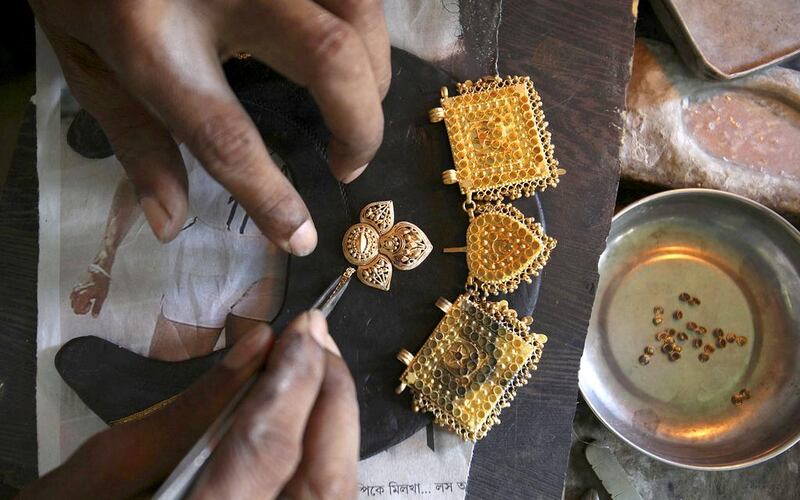MUMBAI // It should be a busy time for Lalit Jain, who owns a jewellery shop in south Mumbai. But his store, Surana Gold, is empty of customers and he says that sales are down by 60 per cent so far during this year’s festive and wedding season in India compared with last year.
“The trust in gold is finished,” he says. “It’s the wedding season, but people are buying lower quantities. Everyone is waiting for prices to come down.”
He blames the country's economic slowdown, along with higher import duties on gold and weakness in the rupee, which has made the precious metal expensive in India.
Gold prices have been volatile there, trading at about 30,000 rupees (Dh1,755) per 10 grams this week compared with about 25,000 rupees in June. In August, prices surged to an all-time high of 34,500 rupees, as the rupee tumbled to record lows against the dollar, with the exchange rate differential making the metal more costly.
Mr Jain says there is unlikely to be a significant increase in demand until prices return to levels of about 25,000 rupees.
Gold plays a significant role in Indian cultural traditions and is often used as an means of storing wealth.
The nation’s government has taken a number of steps to try to curb demand for gold in an effort to narrow the country’s current account deficit and prop up the rupee. These steps have included a series of import duty hikes on gold, which now stands at a record 10 per cent.
“The government regulations have had the intended effect,” says Somasundaram PR, the managing director for India at the World Gold Council (WGC). “India recorded a 32 per cent decline in consumer demand compared to the same quarter last year.”
Gold consumption in India totalled 148 tonnes in the third quarter compared with 310 tonnes in the second quarter of this year, according to the WGC.
The dip in demand means that China is expected to usurp India this year as the world’s biggest gold consumer.
“The demand has been sluggish this festive season compared to last year, witnessing drops of 15 to 20 per cent,” says Lalit Jagawat, the director of the Bombay Bullion Association.
“The physical sale of gold and silver coins saw a very average sale. On the day of Dhanteras [the day during the Diwali festival when Indians traditionally buy gold] the sale was also not very remarkable. On the other hand the marriage season has just started and we are likely to see the demand pick up. However, the demand is not likely to be same as compared to last year due to high prices.”
Arun Awasthi, the vice president of marketing at Infibeam.com, says that while demand for buying jewellery online has surged over the past year, there has been very limited demand for gold during the festive and wedding season.
Gold also seems to have lost some of its lustre with the Indian mutual funds industry.
“Recent volatility in gold prices continued to weigh on the gold exchange traded funds as the category saw outflows [2.9 billion rupees in October] for the fifth month in a row,” according to Crisil. “The category assets declined 5 per cent during the month due to outflows as well as mark-to-market losses to take the total assets under management to below the 100 billion rupees mark.”
Government measures to suppress India’s appetite for gold are believed to have led to an increase in smuggling.
This was illustrated by reports last week that 24 gold bars worth US$1.1 million were found on a plane at Kolkata airport.
Many believe that Indian demand cannot be suppressed for long.
“The intervention of the Indian government in restricting gold imports to the country is obviously reflected in the official levels of demand this quarter, but this by no means indicates that the appetite for gold in India is waning,” says Marcus Grubb, the managing director of investment at the WGC.
“We have seen some increases in demand in other countries which have close links with India, some of which may be making its way back to the country through illicit channels, which have reopened in recent quarters following a long period of inactivity.”
Mr Somasundaram says that he expects demand to pick up as the season continues.
“Year to date, demand remains robust, up 19 per cent compared to the first three quarters of 2012, following the surge in demand sparked by the price fall earlier in 2013,” says Mr Somasundaram.
“Looking at the current period, the seasonality of gold buying is clear, with demand picking up compared to earlier months. The fourth quarter is traditionally a busy season for gold, as it captures post-monsoon rural spending, major festivals and auspicious wedding days and I expect this to be true this year.
“Placing a curb on supply is unlikely to dampen demand in the market. It would be good for the debate to move to how we can ease the regulatory landscape for gold, and view it as a strategic investment asset which can be monetised – thereby using gold to enhance domestic liquidity.”
business@thenational.ae





